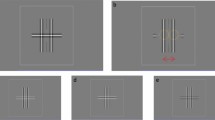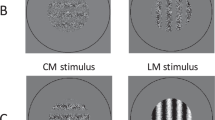Abstract
The Craik-O'Brien illusion was measured for patterns of negative and positive contrast by a compensation method. The illusion of negative contrast (black teeth on uniform field) was stronger than that of positive one (white teeth). The amount of compensation increased linearly with increasing tooth width, but was nonlinear, showing two phases with increasing tooth height. The results might be explained by the concept of the antagonistic and nonantagonistic mechanisms in the lower stage of the visual system, and the reconstructive process of the barrier activity against the lateral spread in the higher stage.
Similar content being viewed by others
References
Békésy, G.v.: Neural inhibitory units of the eye and skin. Quantitative description of contrast phenomena. J. Opt. Soc. Am. 50, 1060–1070 (1960)
Békésy, G.v.: Mach- and Hering-type lateral inhibition in vision. Vision Res. 8, 1483–1499 (1968)
Békésy, G.v.: Compensation method to measure the contrast produced by contours. J. Opt. Soc. Am. 62, 1247–1251 (1972)
Dooley, R.P., Greenfield, M.I.: Measurements of edge-induced visual contrast and a spatial-frequency interaction of the Cornsweet illusion. J. Opt. Soc. Am. 67, 761–765 (1977)
Freund, H.-J., Hennerici, M., Rabenschlag, U.: Reversal of surround- into centre-type responses of cat retinal ganglion cells by local darkening of the receptive field centre. Vision Res. 17, 487–494 (1977)
Gerrits, H.J.M., Vendrik, A.J.H.: Simultaneous contrast, fillingin process and information processing in man's visual system. Exp. Brain Res. 11, 411–430 (1970)
Grossberg, S.: The quantized geometry of visual space: The coherent computation of depth, form, and lightness. Behav. Brain Sci. 6, 625–692 (1983)
Hamada, J.: The contour enhancement effects produced by darkening effects. In: Psychophysical judgment and the process of perception. pp. 132–139. Geissler, H.-G., Petzold, P. eds. Amsterdam: North-Holland 1982
Hamada, J.: Lightness decrease and increase in square-wave gratings. Percep. Psychophys. 35, 16–21 (1984a)
Hamada, J.: A multi-stage model for border contrast. Biol. Cybern. 51, 65–70 (1984b)
Jung, R.: Visual perception and neurophysiology. In: Central processing of visual information. Handbook of sensory physiology. Vol. VII/3; Part A, pp. 1–152. Jung, R. ed. Berlin, Heidelberg, New York: Springer 1973
Mach, E.: Über die Wirkung der räumlichen Vertheilung des Lichtreizes auf der Netzhaut. I. Sitzungsberichte der mathematisch-naturwissenschaftlichen. Classe der Kaiserlichen Akademie der Wissenschaften (Wien) 52, 303–322 (1865)
Magnussen, S., Glad, A.: Brightness and darkness enhancement during flicker: Perceptual correlates of neural B- and D-systems in human vision. Exp. Brain Res. 22, 399–413 (1975)
Marr, D., Hildreth, E.: Theory of edge detection. Proc. R. Soc. (London) B207, 187–217 (1980)
O'Brien, V.: Contour perception, illusion, and reality. J. Opt. Soc. Am. 48, 112–119 (1958)
Ratliff, F.: Mach bands: Quantitative studies on neural networks in the retina. San Francisco: Holden-Day 1965
Spillmann, L., Fuld, K., Gerrits, H.J.M.: Brightness contrast in the Ehrenstein illusion. Vision Res. 16, 712–719 (1976)
Spillmann, L., Fuld, K., Neumeyer, C.: Brightness matching, brightness cancellation, and increment threshold in the Ehrenstein illusion. Perception 13, 513–520 (1984)
Watt, R.J., Morgan, M.J.: Mechanisms responsible for the assessment of visual location: theory and evidence. Vision Res. 23, 97–109 (1983)
Author information
Authors and Affiliations
Rights and permissions
About this article
Cite this article
Hamada, J. Asymmetric lightness cancellation in Craik-O'Brien patterns of negative and positive contrast. Biol. Cybern. 52, 117–122 (1985). https://doi.org/10.1007/BF00364002
Received:
Issue Date:
DOI: https://doi.org/10.1007/BF00364002




